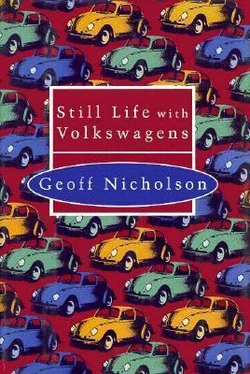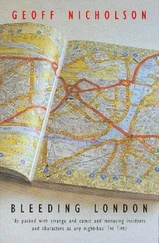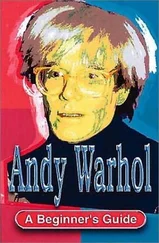“Les, that’s just terrible.”
“I know. I know. But the thing is, I did it with those neo-Nazi Volkswagens too.”
“You did?”
“Yeah,” and he pulls a little black box out of his pocket, a thing that looks not unlike a remote control for a television set, though this one has more switches and LEDS, a few loose wires and one very big red button.
“I press that,” says Les, “and it’s bye-bye to eight wicked-looking black Volkswagens.”
Outside they can hear Phelan ranting on about the Aryan race, world domination and the triumph of the will. It’s very eloquent, very compelling and grand, and even if it might be construed as a little overdramatic and dictatorial, he undoubtedly has the crowd where he wants them. They are hanging on his every word, applauding and cheering, and here and there his name is being chanted.
Barry says, “You mean you press that button and the cars all blow up.”
“Yep. Just like that,” says Fat Les.
“I think we have to do it, don’t we?”
“I think we do.”
They leave the teepee. This is something they want to see with their own eyes. Phelan is no longer speaking, just basking in the adulation of his new followers, holding Hitler’s Volkswagen aloft. Then someone appears on the stage beside him. It is a bedraggled old man with a skinhead haircut, Charles Lederer, looking his wildest to date.
Phelan does not want to share the stage with anyone and yet he hesitates for a moment, perhaps thinking it’s a fervent supporter who’s got a little carried away with enthusiasm. Certainly he thinks the old man looks harmless and unthreatening. Charles Lederer approaches, gets very close, and his hands are extended as though he wants to congratulate Phelan. But what he actually wants to do, what he succeeds in doing, is lay his hands on Hitler’s Beetle. Phelan is caught off guard. Charles Lederer’s fingers make contact with the model, but the laying on of hands is not enough for him. He grabs the Volkswagen and dashes away across the stage, and even as Phelan lunges after him, even as he summons a few skinheads to deal with the situation, Charles Lederer winds back his throwing arm and flings the Volkswagen hard and high away from the stage, up over the heads of the crowd.
It is a mighty throw. The model rises and rises in the air. It reaches the top of its parabola of flight and seems to hang there, crystalline and perfect, showing itself to the multitude, spinning like a tiny lost planet. Phelan yells through the mike, “Catch it. But gently.” Thousands of eyes look up. Dozens of pairs of hands steady themselves ready to catch the falling Volkswagen if it comes their way.
Fat Les holds out the remote control to Barry.
“Would you do me the honour?”
“I certainly would.”
Barry presses the button, there’s a pause, and then, at the edges of the field, eight black, wicked-looking Volkswagens, each one more or less a replica of his own Enlightenment, explode in banks of searing flame.
The synchronised noise is terrifying, and this crowd has a great talent and propensity for terror. Black smoke rolls across the field. A huge, multivoiced scream goes up. It’s as though a war’s started. They stampede again, bouncing off each other as they go. The wall of fire surrounding the field no longer seems like such a great obstacle, and they run so fast through the flames that they don’t even feel the heat.
The falling Volkswagen, formerly property of Adolf Hitler and Carlton Bax, is totally forgotten. It drops unnoticed into a scrum of frenzied hippies, hits someone on the back of the neck, then falls to the muddy ground where any number of running feet crush and destroy the beautifully-made automaton.
On the scaffolding stage Phelan drops to his knees. Beside him Charles Lederer stands tall and firm, and seen a certain way it might look as though Phelan is kneeling at his feet in prayer. Charles Lederer looks out over the field. He doesn’t exactly understand what’s been going on here, nor what his part in it was, but he feels extremely, peculiarly pleased with himself, as if the simple laying on of his hands was enough to destroy all his demons.
Barry and Fat Les stand and watch. They are stunned but gratified, and they watch with renewed amazement as a white car emerges from the smoke and mayhem. It is a white BMW and it makes slow, stately progress through the running crowd, avoiding bodies and tents and the burning wrecks of Volkswagens. It looks serene and other-worldly.
As the smoke clears a little the driver is revealed to be Cheryl Bronte. Beside her sits Renata Caswell, and in the back of the car are Marilyn Lederer and Carlton Bax. They are holding onto each other for dear life. They look wretched and traumatised, and yet they look totally, hopelessly, in love. Barry has seen some strange sights today, but this is one thing he cannot bear to look at.
Ten.I Beg Your Pardon, I Never Promised You a Volkswagen
The noise of twin carburettors and stinger exhausts screams across the sky. There is a curl of blue smoke, the smell of multigrade and four star and teen spirit, the sound of radials on loose gravel, a squeal of overheated brake pads. Here they come, a procession, a danse macabre, something stately and dangerous, new-fangled yet elemental. They come in different styles and colours, in different specifications, with or without optional extras. They suit different personalities, satisfy different needs, are the products of different obsessions, but in the end, one size fits all.
Here they come, the heroes and the bad guys, the lovers and killers, the good, the bad, the pranksters and fugitives and collectors, the winners and posers, the hippies and cops, the postmen, the surfers, the ravers; all driving Volkswagen Beetles, always crashing in the same car. Everyone has a Volkswagen story. Everyone is a driver or a passenger.
Here are some Disney executives at the boardroom table having a brainstorming session, some time in the late sixties. “Hey it’s freaky out there. Everybody’s taking drugs, marching on the Pentagon burning their draft cards, what we need is some mawkish sentimental crap for the family audience. And sure, we’ve made plenty of mawkish sentimental crap about wildlife and children, but hey, let’s face it fellers, the times they are a changing. How about this for a concept? Let’s make some mawkish sentimental crap about an anthropomorphic Volkswagen!!!!! Far out or what?”
In fact they get through about thirty different Herbies in the making of The Love Bug and the true Beetle obsessive will spot that the cars used vary from 1966 through to 1969 models. These days, only one Herbie stands in the Volkswagen museum at Wolfsburg, with the number 53 on its doors and bonnet, and the legend ‘Gross in Fahrt’ painted along its sides. But, of course, since the car has to be seen to race and beat Corvettes and Ferraris, most of the stunt cars have to use a Porsche engine. But that’s okay, that’s authentic enough, that’s just the nature of film, that’s just showbiz.
Here is Ralph Nader, pioneer of consumer safety, the man who nixed the Chevrolet Corvair, and he isn’t at all happy about this Bug mania that’s sweeping the country. They’re strange and foreign and popular as Hell and it sure wouldn’t do his profile any harm if he could prove they were rolling Germanic death traps. So he looks at them and drives them and takes them apart and crashes them, and in the end all he can find to complain about is the fact that in the event of a serious collision, the petrol cap cover might, you know, fly off and hurt somebody.
Here is Ivan Hirst, the man who brought the Wolfsburg factory back to life after the allied conquest of Germany, the man who more than anyone else was responsible for the postwar rebirth of the Volkswagen Beetle. It is 1989 and he is living in the village of Marsden in West Yorkshire, a Volkswagen Golf GTi in his garage, and a neighbour asks him is it true he used to work for Volkswagen.
Читать дальше












